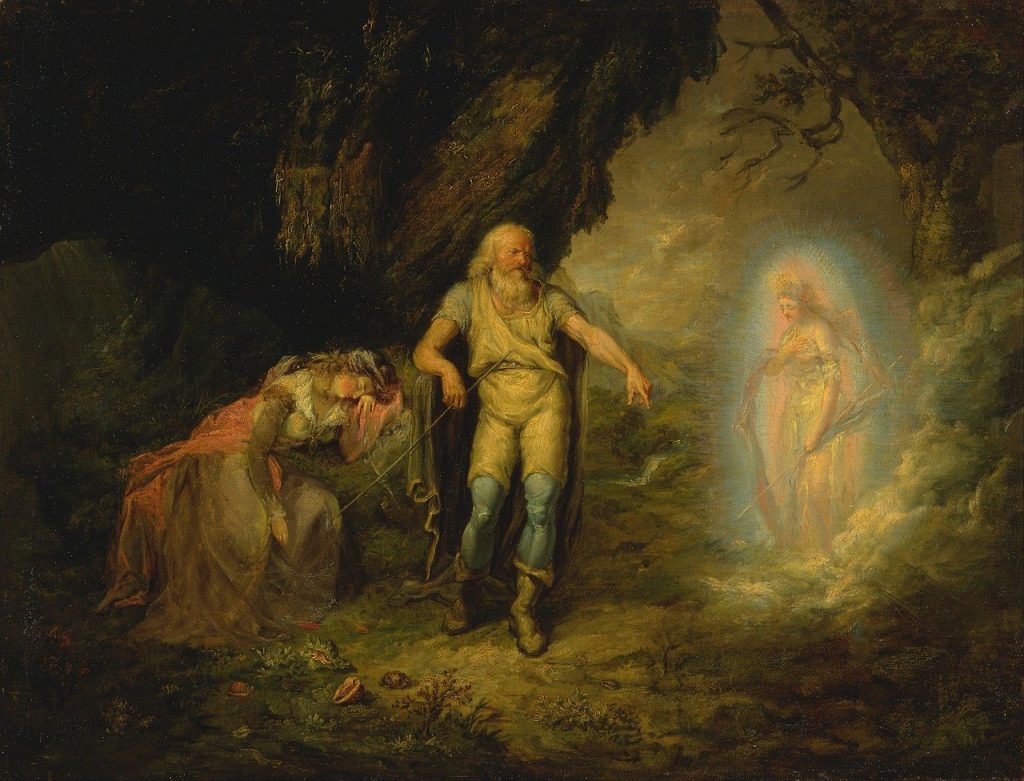
Man in the Seats by Caspar Ewig
A Review of Glimmer Globe Theatre’s ‘The Tempest’
COOPERSTOWN—Wednesday, July 12 saw the opening of the month-long presentation of Shakespeare’s “The Tempest” at Fenimore Art Museum, which will be presented every Wednesday and Thursday until August 10. The play is being performed by the Glimmer Globe Theatre players under the direction of Michael Henrici who, with wife Danielle, has organized and presented many Shakespearean plays in the past, including last year’s “Romeo and Juliet.”
The cast features Lissa Sidoli as Prospero, the previously banished Duke of Milan, who narrates the back story regarding the reasons that caused him to use his magical powers to set the stage for the intended revenge against his brother, Antonio, played by J. Lentner. Antonio had conspired with King Alonso of Naples, played by Peter Exton, to strip Prospero of his dukedom. The remaining members of the shipwrecked crew were portrayed by local thespians, with special note to the world premiere appearances of Dashiell Henrici, Tessa Davis and Gavin Abrams as the three nymphs.
Our recent tempestuous weather kindly held off to permit “The Tempest” to be performed under open skies at the Lucy B. Hamilton Amphitheater. However, Friday the 13th occurred on Thursday last month, and that evening’s weather tempest required that the dramatic “Tempest” be moved indoors to the Louis C. Jones Center at The Farmer’s Museum.
An external tempest would seem rather appropriate, since the play opens on the bridge of a ship that is about to be wrecked on the shoals of some godforsaken uninhabited island. But the required relocation from the outdoor to the indoor venue was unfortunately inappropriate because of the negative sound effects which interfered with the presentation of the play.
The success of any performance hinges on the audience’s ability to hear and understand the spoken word. The beauty of any Shakespearean work is in the language; the soliloquies are famous not only for their subject, but also their literary style. For this reason, the site of the performance is critical. In the open air of the amphitheater, the dialogue could be heard distinctly, but the reverberation in The Farmer’s Museum site made it difficult to follow the storyline.
Tragedies such as “Hamlet” and “Julius Caesar” have sufficient action to keep the audience focused even if some of the dialogue cannot be clearly heard. But in plays like the “Tempest,” where the action is minimal, and where the only place to get the story is in the lengthy narrative (but not soliloquy) of Prospero, the clarity of the dialogue is critical, but was lacking.
Two recommendations that would assist in filling in the gaps where the audience might not have caught the dialogue are to, first, put a short synopsis of the plot into the program, and, in my mind equally important, list the characters in the program in the order of their appearance. Otherwise, short of having each one display a Post-it note on his forehead, it becomes impossible to know who is who at the beginning of the play.
On a larger level, the decision to schedule all performances on Wednesday and Thursday nights makes it difficult or impossible for many community members and area visitors to attend. A number of local residents have expressed their regret that family and friends visiting them during weekends will be unable to enjoy the show.
“The Tempest” is a difficult play to perform in that the moral themes of revenge, sorrow, and forgiveness are ethereal concepts whose presence exists only in words, and not action.
The entire cast and crew did a remarkable job in its presentation.
Caspar Ewig is a contributing writer to “The Freeman’s Journal” and “Hometown Oneonta” who enjoys sharing his theater experiences with others.

